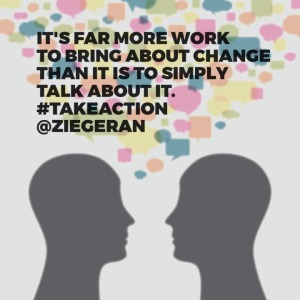My Theory of Leadership in 3 Words

Many leaders have their list of favorite authors: Kotter, Maxwell, Whitaker, Collins – to name a few. When I want to learn about something new, my first reaction is to immerse myself in text about that subject. Based on this reading and research I have developed some go-to beliefs and practices, which help guide my decision making on a daily basis.This November I close in on my first full year in an official leadership position. I obviously still have a lot to learn and experience, but I have made one clear conclusion this year. I now know there is one thing that differentiates a great leader from just a leader by title and this ultimate differentiator can be summarized in just three words. Great leaders: Do. The. Work.
I love to read. I enjoy theory, but theory can get in the way of progress. When leaders spend too much time talking and not enough time experiencing, experimenting, and listening, we are impeding the progress of our organizations. Leadership 101 told you to set a vision and most districts and schools have visions or goals recorded somewhere. An unfortunate, yet common, setback is spending too much time reading or discussing our practice and not spending enough time actually practicing. If a vision is presented and then teachers are left in hamster wheels spinning away, real work is not getting done. Help disassemble the hamster wheels, lay the new track in the right direction, and connect the tracks to establish teamwork and collaboration for your faculty. Do. The. Work.
What does doing the work look like?
1. Go to planning meetings.
When teachers meet to discuss or plan instruction, be there. This is your opportunity to provide job embedded professional development. Help locate quality resources or instructional practices. The implication here is not that these meetings become administrator led. Instead, I encourage you to become an organic member of the group. Provide coaching when necessary. Share your input when appropriate, but most of all, be a good listener.
2. Spend time in classrooms to support teachers who are taking risks.
Teachers, like students, are looking for feedback. In order for our feedback to be timely and specific – necessary characteristics of effective feedback – we must be present in classrooms. Encourage teachers to invite you if there is a lesson of which they are particularly proud, but make visibility a priority. Not receiving a direct invite is not an excuse for poor visibility. Which brings me to my next thought…
3. Listen to what your building needs, and take action.
If you are out in your building or district listening, needs will become apparent. We need to be proactive with this information. Even if a teacher or student has not asked a direct question or directly expressed a concern, take action. This works wonders for building morale.
4. Do paperwork when students and teachers are not in the building.
Seeing a pile of papers on my desk is a challenge for me. I hate the idea of paperwork hanging over my head, but the paperwork still exists when the students and teachers are gone for the day. Make the time with people the priority. There are plenty of other things – behavior issues, crisis situations, etc – that absorb your time, but paperwork we can control.
DO NOT throw theory out the window.
As I mentioned earlier, I love to read. I am not implying that we should stop reading or exploring. When a new theory is presented the next question should be, now what? How does this affect our practice? What will we DO next? Use your colleagues, PLN, or an EdCamp to explore and discuss actionable steps. Ask questions and probe for concrete examples. But then, most importantly, come back to your organization and Do. The. Work.
How do you translate theory into action in your district?


